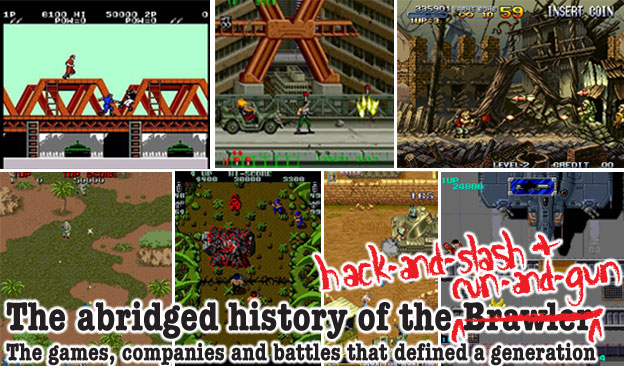
The previous blog mentioned the migration of the run-and-gun from the overhead to the side scrolling format. Several studios were experimenting with what could be accomplished with the different camera perspectives. Sega had a stealth style game called Crack Down in 1989. It allowed two players in the role of special agents to travel through maze-like factories and offices while planting bombs and sabotaging the plans of a mad scientist. The levels were presented on two half screens for each player with a shared map at the top of the display. This allowed both players to move independently from each other and meet up at the exit once the objectives had been reached. This independent gaming was something never tried before in brawlers or other genres in arcades.
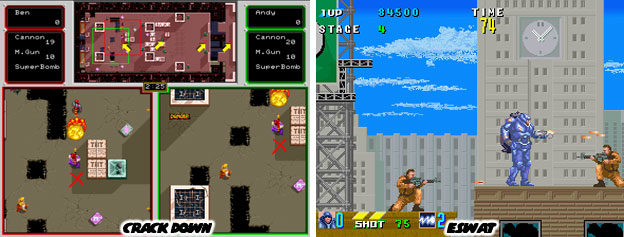
A year later Sega returned to the super cop theme in the game ESWAT. The title ditched the espionage format from Crack Down and went with a side scrolling shooter. In that title players took a cop through the ranks from beat cop to ESWAT (Enhanced Special Weapons and Tactics) officer. They earned power armor to take down massive opponents like helicopters, robots, monster trucks and giant gorillas.
Through the 80’s and 90’s a solid theme always took advantage of the available technology. The original Metal Gear, released in 1987 by Konami was set in an overhead perspective and it allowed gamers to run, gun, sneak and spy. The game probably would not have been as successful if it were in a side scrolling format.
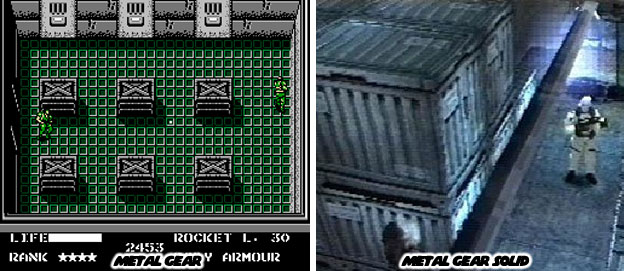
By 1998 when technology improved Hideo Kojima and company delivered a much richer experience in 3D through Metal Gear Solid. Hideo always fancied that the game would work in 3D and took every effort to make sure that players understood that his game was more about stealth, inventory management and logical puzzle solving rather than just running and gunning. Not every game was able to make the transition into 3D and find some level of success. One of the earliest hack-and-slash titles also included RPG elements of inventory management and magic.
Gauntlet was released by Atari in 1985. It was a wildly popular arcade game that laid the foundation for every multi-player, arcade hack-and-slash title. Players could choose between a warrior, valkyrie, wizard and elf, each with close and ranged attacks. Gamers could not stop pouring quarters into the title through most of the 80’s. Without it making the fantasy genre accessible then there probably would not have ever been Capcom’s amazing Dungeons and Dragons or Treasure’s Guardian Heroes.
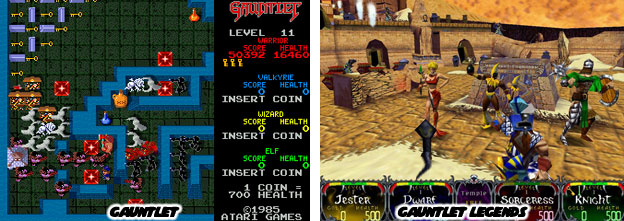
Unfortunately when Williams decided to dust off the license in 1998 and put it back in the arcades with updated character designs, mazes and 3D graphics the players did not really seem to notice. Gauntlet Legends was feature-for-feature a superior title but the gameplay lacked. Williams did not understand that because the title moved to 3D it did not mean the gameplay was able to make the transition as well. There was almost the same amount of time separating Metal Gear and Metal Gear Solid as there was between Gauntlet and Gauntlet Legends. Some games worked well in 3D but by and large not the brawling experience, or in this case the hack-and-slash. I had pointed out the nuances in control and gameplay that suffered in 3D when the brawler moved to that format in previous blogs.
Sega found out the same thing for their side scrolling brawler Altered Beast. The 1988 title was a cult favorite. Players took on the role of a resurrected Greek hero as he fought through waves of undead creatures and monsters to save a princess. Along the way the character could power up and transform into a half man half creature including a werewolf, weretiger and werebear. Each creature had their own special attacks and could even be supported by a second player.
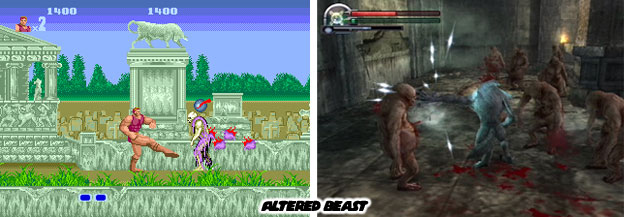
WOW Entertainment, a Sega in-house studio, decided to bring back Altered Beast in 2005. They expanded the library of creatures that the hero could transform into and even updated the story to make it contemporary. Science rather than magic caused the hero to mutate into different beasts. The title was panned by players and reviewers. The transition to 3D, updated story and loose controls could not hold a candle to the original brawler.
Other studios would find that working closely in the side scrolling format could be successful if they kept experimenting with gameplay elements and themes. The next blog will highlight games that combined elements of the run-and-gun with the side-scrolling brawler. Without these titles introducing new elements then modern brawlers like Double Dragon and Final Fight might never have existed. As always if you enjoyed this blog and would like to sponsor me please visit my Patreon page and consider donating each month, even as little as $1 would help make better blogs and even podcasts!

No comments:
Post a Comment